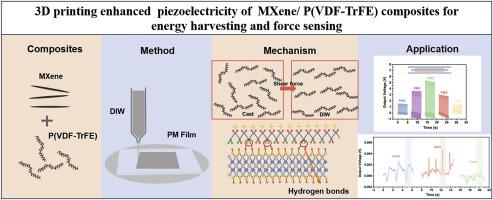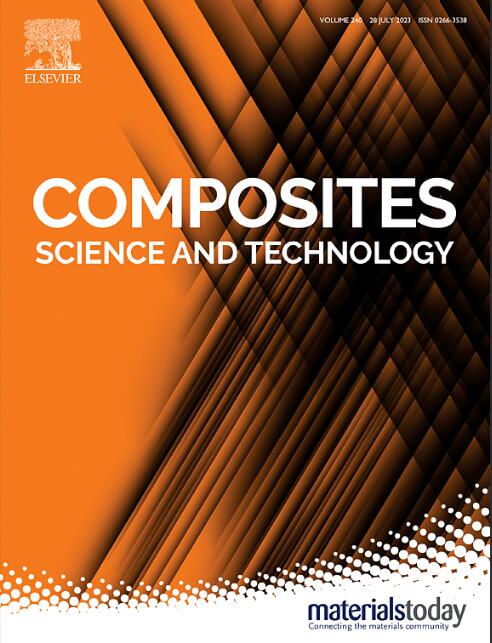3D printing enhanced piezoelectricity of MXene/P(VDF-TrFE) composites for energy harvesting and force sensing
IF 8.3
1区 材料科学
Q1 MATERIALS SCIENCE, COMPOSITES
引用次数: 0
Abstract
In pursuit of advanced self-powered wearable devices, piezoelectric materials have aroused great attention due to their stable energy harvesting ability from surroundings. However, traditional piezoelectric polymer-based nanogenerators necessitate a high-energy process to align the dipoles of the polymer, which is cumbersome, expensive, and could even lead to material deterioration. To address this challenge, we present a composite strategy with self-poling capability enabled by the extrusion-based 3D printing. MXene nanosheets were introduced into the fluoropolymer poly(vinylidene fluoride-co-trifluoroethylene) (PVDF-TrFE) to provide strong hydrogen bonding as anchors. Under the shear stress generated by the extrusion process, the alignment of the dipoles was realized without additional treatment. The resulting piezoelectric nanogenerator exhibits an open-circuit voltage of 5.5 V, a short-circuit current of 1.1 μA, and the output power density of 68 μWcm−3 under the force of 22 N and a frequency of 2 Hz. A self-powered sensor was assembled and demonstrated high sensitivity for human motions and facial expressions. Moreover, the 3D-printed piezoelectric composites present good flexibility, which is a crucial property for wearable devices. With the free design capabilities of the 3D printing technology, this strategy may pave the way for customized and feasible processing of high-performance piezoelectric nanogenerators and force sensors.

三维打印增强 MXene/P(VDF-TrFE)复合材料的压电性,用于能量采集和力传感
在追求先进的自供电可穿戴设备的过程中,压电材料因其能够稳定地从周围环境中收集能量而备受关注。然而,传统的基于压电聚合物的纳米发电机必须采用高能量工艺来调整聚合物的偶极子,这种工艺既麻烦又昂贵,甚至会导致材料老化。为了应对这一挑战,我们提出了一种复合策略,通过基于挤压的三维打印技术实现自校正能力。我们在氟聚合物聚偏二氟乙烯-共三氟乙烯(PVDF-TrFE)中引入了 MXene 纳米片,以提供强大的氢键作为锚。在挤压过程产生的剪切应力作用下,无需额外处理即可实现偶极子的排列。由此产生的压电纳米发电机在 22 N 的力和 2 Hz 的频率下,开路电压为 5.5 V,短路电流为 1.1 μA,输出功率密度为 68 μWcm-3。自供电传感器已组装完成,对人体运动和面部表情具有高灵敏度。此外,三维打印压电复合材料具有良好的柔韧性,这对于可穿戴设备来说是至关重要的特性。借助三维打印技术的自由设计能力,这一策略可为定制和加工高性能压电纳米发电机和力传感器铺平道路。
本文章由计算机程序翻译,如有差异,请以英文原文为准。
求助全文
约1分钟内获得全文
求助全文
来源期刊

Composites Science and Technology
工程技术-材料科学:复合
CiteScore
16.20
自引率
9.90%
发文量
611
审稿时长
33 days
期刊介绍:
Composites Science and Technology publishes refereed original articles on the fundamental and applied science of engineering composites. The focus of this journal is on polymeric matrix composites with reinforcements/fillers ranging from nano- to macro-scale. CSTE encourages manuscripts reporting unique, innovative contributions to the physics, chemistry, materials science and applied mechanics aspects of advanced composites.
Besides traditional fiber reinforced composites, novel composites with significant potential for engineering applications are encouraged.
 求助内容:
求助内容: 应助结果提醒方式:
应助结果提醒方式:


